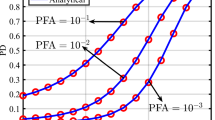Abstract
In this paper an approximate decorrelating detector is analyzed on the basis of a first order approximation to the inverse crosscorrelation matrix of signature waveforms. The approximation is fairly accurate for systems with low crosscorrelations and is exact in the two-user synchronous case. We present an exact as well as approximate analysis of the bit-error-rate performance of this detector on a channel that is subject to flat fading, and also specifically for the case of random signature waveforms. The detector outperforms the conventional matched filter receiver in terms of BER. The approximate decorrelator (while not being near-far resistant like the decorrelating detector) is fairly robust to imperfections in power control. Power trade-off regions are identified which characterize the significant advantage that the approximate decorrelator provides over the matched filter receiver. The reduced complexity of the approximate decorrelator and performance gains over the conventional matched filter makes it a viable alternative for implementation in practical CDMA systems, in particular in those where the signature waveforms span many symbol intervals.
Similar content being viewed by others
References
R. Lupas and S. VerdÚ, “Linear multiuser detectors for synchronous code-divisionmultiple-access channels,” IEEE Trans. Info. Theory, Vol. IT-34, pp. 123–136, Jan. 1989.
M.K. Varanasi and B. Aazhang, “Multistage detection for asynchronous code-division multiple-access communications,” IEEE Trans. Commun., Vol. COM-38, pp. 509–519, Apr. 1990.
S. VerdÚ,“AdaptiveMultiuser Detection”, Proceedings of IEEE International Symposium on Spread SpectrumTheory and Applications, Oulu, Finland, 1994.
S. VerdÚ “Multiuser Detection”, Advances in StatisticalSignal Processing, Vol. 2, pp. 369–409, JAI Press Inc.
“Mobile Station-Base Station CompatibilityStandard for Dual-Mode Wideband Spread Spectrum Cellular System”, CIA/TIA IS-95, 1993.
U. Madhow and M. L. Honig, “MMSE Detection of Direct-Sequence CDMA Signals: Analysis for RandomSignature Sequences”, Proceedings of IEEE International Symposium on Information Theory, San Antonio, Texas, 1993.
J.M. Holtzman, “On Using Perturbation Analysis to do Sensitivity Analysis: Derivativesvs. Differences”, IEEE Trans. on Automatic Control, Vol. 37, No.2, 1992, pp. 243–247.
J.M. Holtzman, “A Simple Accurate Method to Calculate Spread-Spectrum Multiple Access ErrorProbabilities”, IEEE Trans. on Communications, Vol. 40, No.3, 1992, pp. 461–464.
Z. Kopal, “Numerical Analysis”, 2nd edn. New York: Wiley, 1964.
Author information
Authors and Affiliations
Rights and permissions
About this article
Cite this article
Mandayam, N.B., Verdú, S. Analysis of an Approximate Decorrelating Detector. Wireless Personal Communications 6, 97–111 (1998). https://doi.org/10.1023/A:1008852822553
Issue Date:
DOI: https://doi.org/10.1023/A:1008852822553




